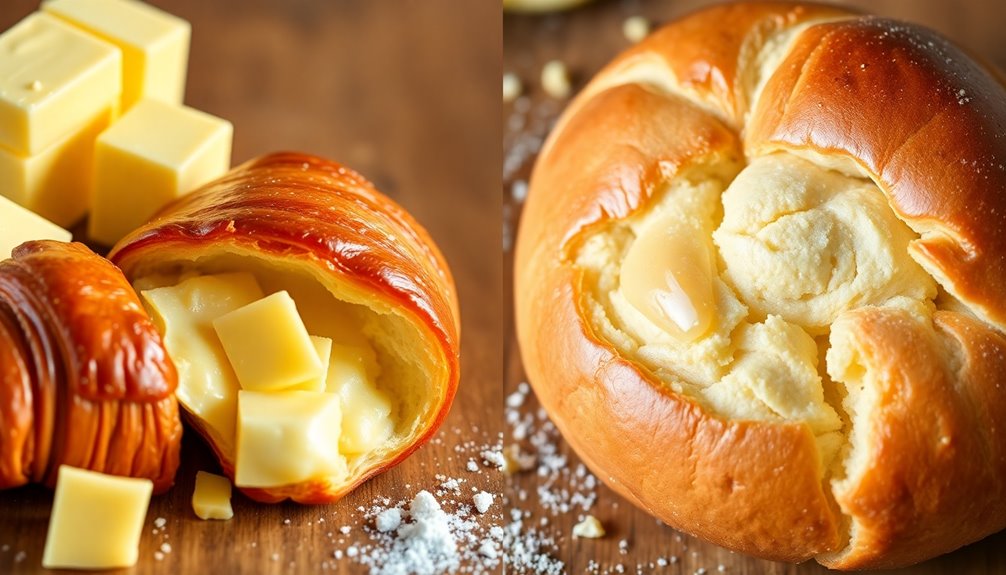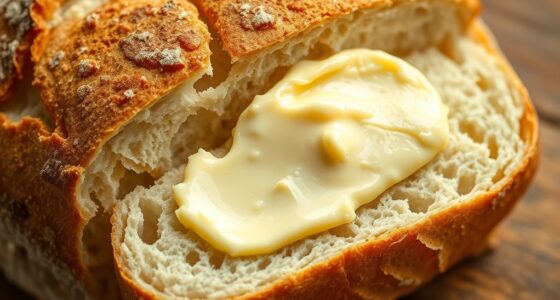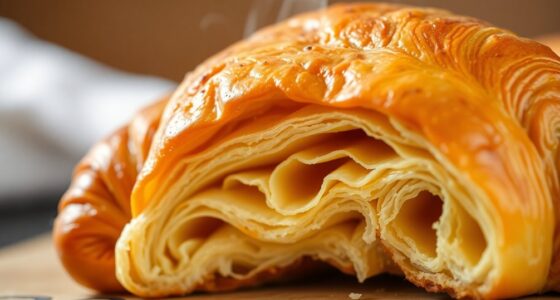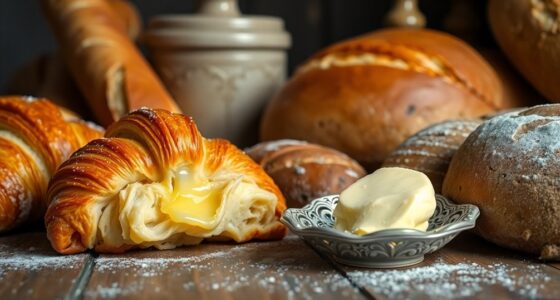When it comes to baking bread and pastries, butter generally wins out over margarine thanks to its rich flavor and high fat content, which creates delightful, flaky textures. Butter melts at a lower temperature, allowing for better control of spread and lift, while margarine's higher water content can lead to denser results. If you care about taste and texture, butter's the choice for superior baked goods. Let's explore what else you should know about this baking debate.
Key Takeaways
- Butter's high fat content promotes a lighter, flakier texture in pastries, enhancing overall quality compared to margarine.
- The rich, natural flavor of butter elevates the taste of baked goods, while margarine often lacks depth.
- Butter melts at a lower temperature, allowing for better control over spread and lift in baking.
- Margarine's higher water content can result in denser, greasier baked goods, compromising texture and enjoyment.
- While butter is pricier, its superior flavor and texture can attract repeat customers, impacting long-term financial outcomes.
Understanding Butter and Margarine
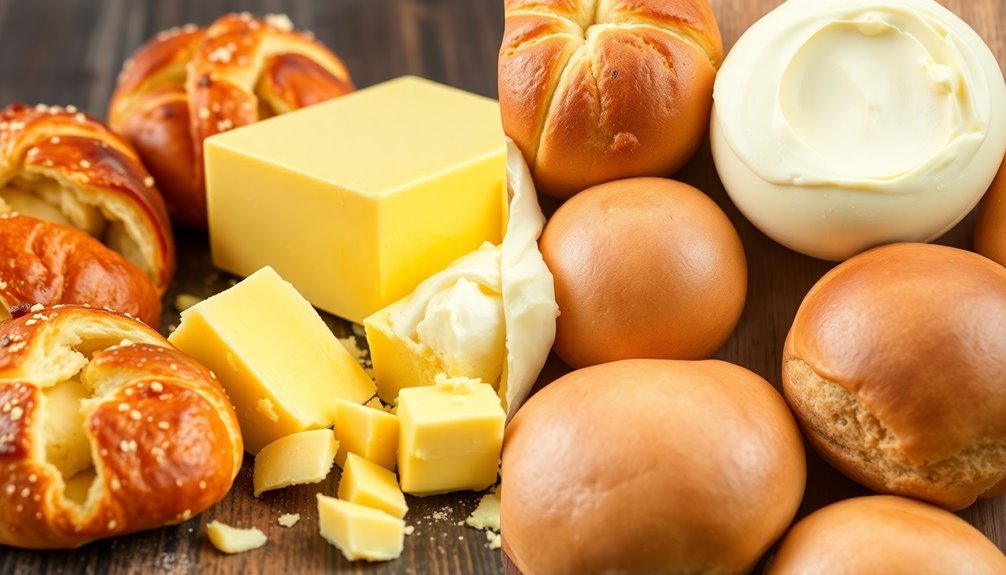
When it comes to baking, the choice between butter and margarine can considerably impact your results.
Butter, made from dairy cream, contains at least 80 percent milkfat, offering a high fat content that helps create flaky textures in pastries. Its lower melting point allows for better control over spread and lift, especially in cookies.
On the other hand, margarine, which is primarily composed of vegetable or animal fats, also meets the 80 percent milkfat requirement but often has higher water content. This can lead to denser, greasier baked goods that lack the rich flavor and desirable mouthfeel of butter.
Understanding these differences is essential for achieving the best results in your baking endeavors.
Flavor Profiles: Butter vs. Margarine
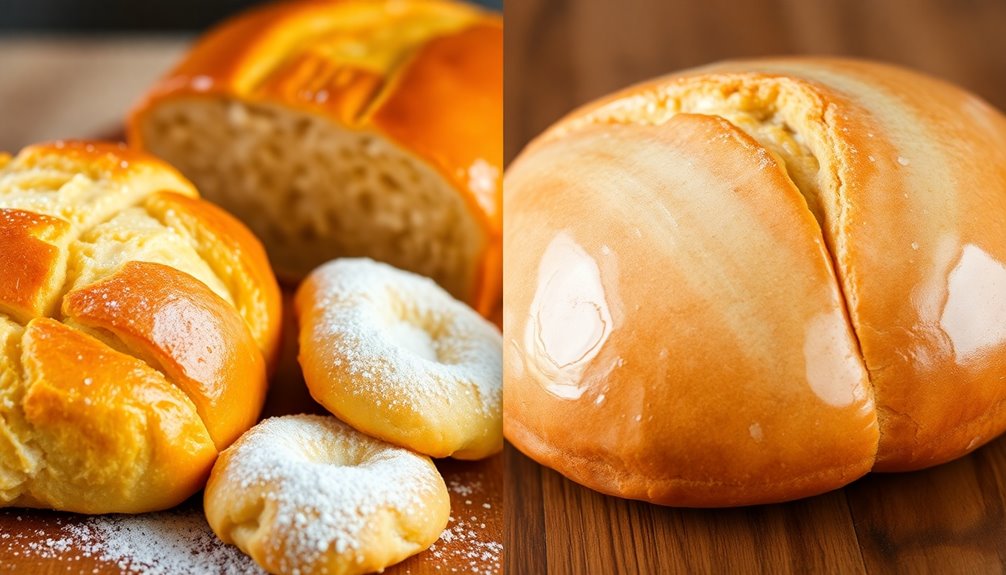
Choosing between butter and margarine goes beyond just fat content; it directly affects the flavor of your baked goods.
Butter provides a rich, natural flavor that enhances the taste of bread and pastries, making them more indulgent. Its creamy, slightly sweet taste creates an enjoyable sensory experience, often leading to a more satisfying outcome in desserts.
In contrast, margarine lacks the depth and complexity of butter's flavor, resulting in less flavorful products. Baked goods made with margarine may taste more processed and less rich, while those made with butter have a pronounced, delightful taste.
When it comes to pastries, butter truly shines, contributing greatly to the overall richness and enjoyment of your final baked items.
Texture and Baking Performance
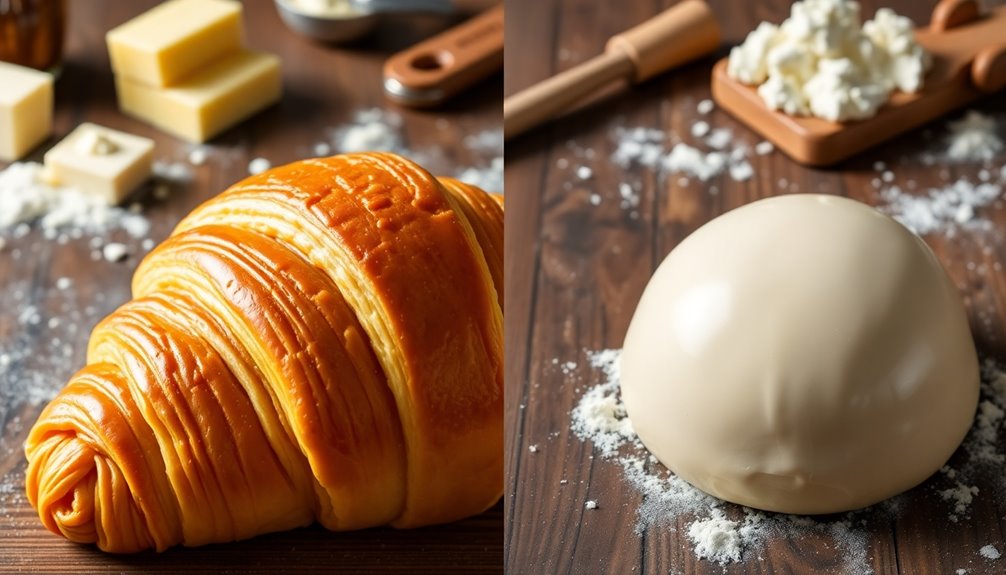
While both butter and margarine can be used in baking, their impact on texture and performance is noticeably different.
Butter's high fat content creates a lighter, flakier texture, perfect for pastries like puff pastry and croissants. Its cold temperature generates steam during baking, promoting airy layers.
In contrast, margarine's higher water content often results in denser, greasier baked goods, compromising your desired texture. Additionally, butter melts at a lower temperature, giving you precise control over the spread and lift of cookies and other treats.
The consistent fat content of butter guarantees reliable baking performance, while margarine's variability can lead to unpredictable results. For the best texture in your baked creations, butter tends to be the superior choice. Moreover, the high sugar and fat content in ice cream can also affect baking outcomes if used as an ingredient.
Nutritional Considerations
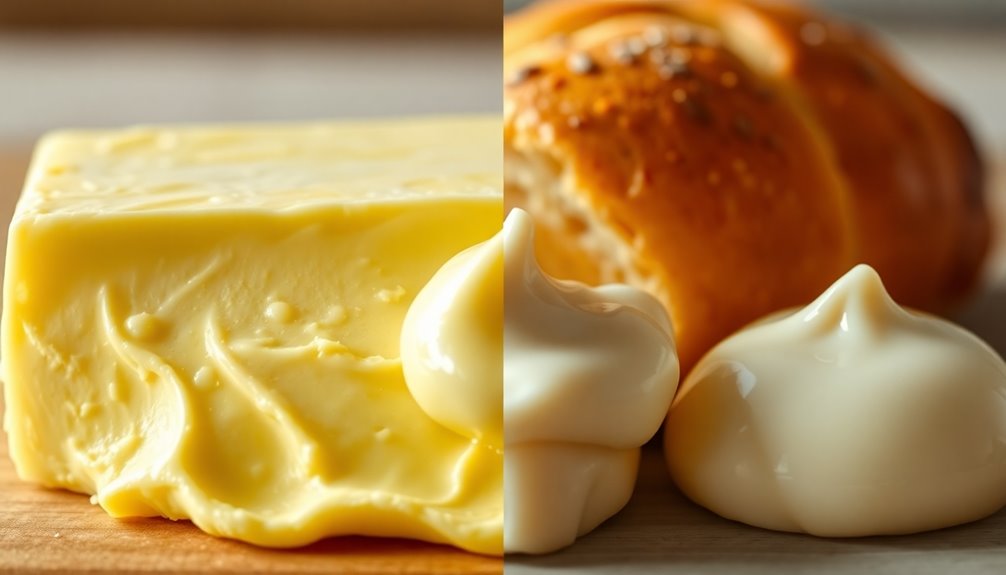
Nutritional considerations play a significant role in the butter versus margarine debate, impacting both your health and the quality of your baked goods.
Butter is high in saturated fatty acids, which some people prefer for its rich flavor and texture, but it also contains beneficial nutrients like vitamin A and Omega-3s.
On the other hand, margarine often has lower saturated fat levels, making it a popular choice for those managing cholesterol. However, some brands may include artificial additives and trans fats.
Both options are high in calories, so moderation is essential.
Ultimately, your choice can affect not only your health but also the final taste and texture of your bread and pastries. Additionally, incorporating herbal teas can provide calming effects and support overall well-being during your baking sessions.
Substitution Tips for Baking
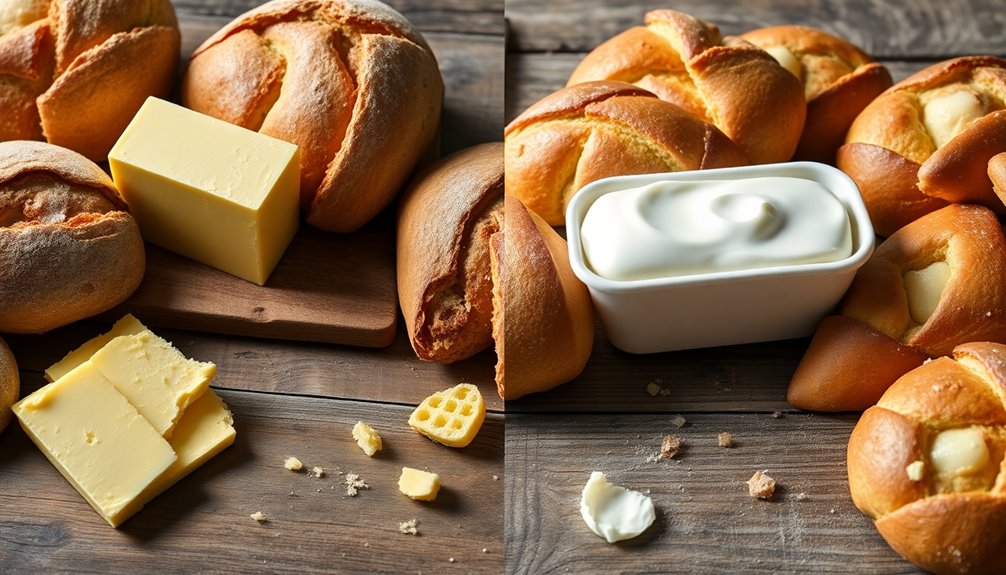
When you're substituting margarine for butter in baking, it's important to contemplate how the flavor and texture will change.
Stick with a 1:1 ratio, but remember that margarine can make your treats softer and denser.
To get the best results, choose stick margarine and pay attention to how it impacts your baked goods.
Flavor Impact Assessment
Flavor plays an essential role in baking, and your choice between butter and margarine can greatly impact the final taste of your baked goods.
Butter provides a richer, more complex flavor that enhances the taste of bread and pastries, making it the preferred option. When you substitute margarine for butter, you might notice a softer texture and a less intense flavor because margarine's higher water content lacks depth.
If you need to use margarine, opt for melted stick margarine instead of tub varieties, which can dilute flavor due to lower fat content.
For the best results, consider blending butter and margarine to achieve a balance of richness and moisture without compromising the overall flavor impact of your creations. Additionally, using butter can enhance the overall skin hydration benefits in baking recipes that require moisture.
Texture Comparison Insights
While both butter and margarine can serve as fats in baking, their differences in texture can greatly influence your results.
Butter's high fat content creates a lighter, flakier texture in pastries, allowing steam to develop layers, while margarine's higher water content can result in denser, greasier baked goods.
When making bread, butter enhances the dough's structure and flavor, whereas margarine might yield a softer crumb and less flavor.
For crispy textures like cookies or pie crusts, butter is ideal as it promotes crispiness.
If you choose to use margarine, stick margarine is the better option over tub varieties, since tub margarine often has more water, negatively impacting the final texture of your baked goods. Additionally, butter is a source of vitamins that contribute to overall health, further enhancing its appeal in baking.
Best Practices for Substitution
How can you effectively substitute margarine for butter in your baking? Here are some best practices to guarantee your baked goods turn out great:
- Stick Form: Use stick margarine to match the fat content and achieve similar texture and consistency as butter.
- Equal Amounts: For recipes needing melted butter, substitute with melted margarine in equal amounts, but skip softened margarine.
- Adjust Baking: Be ready to tweak baking times and temperatures, as margarine may need adjustments for proper browning and rise.
- Flavor Boost: Since margarine lacks the rich taste of butter, taste your batter and adjust flavorings to enhance your baked goods.
Additionally, consider incorporating compound butter recipes for a flavorful twist in your baked treats.
With these tips, you can navigate the margarine vs butter debate and still create delicious treats!
Cost Analysis: Butter vs. Margarine
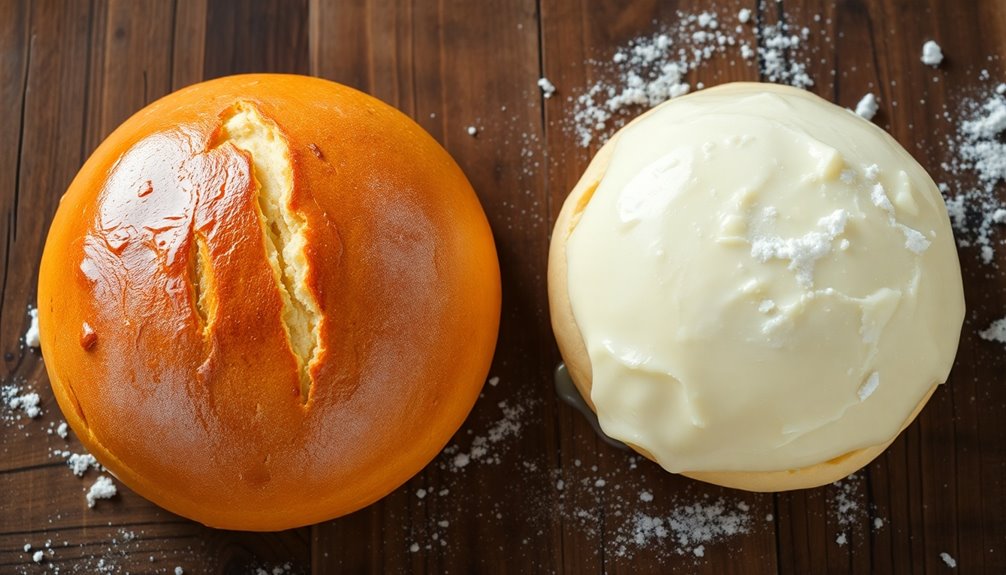
When you're considering costs in baking, butter and margarine present clear differences.
Butter usually comes with a higher price tag, averaging $3 to $5 per pound, while margarine is the more affordable choice at around $2 to $3.
However, the long-term financial impact of using butter could be worth it if you value its flavor and versatility in your baked goods.
Price Comparison
Comparing prices reveals that butter generally costs more than margarine, with prices ranging from $3 to $5 per pound for butter and $2 to $4 for margarine.
This price comparison highlights several key points:
- Quality: Butter's higher price reflects its quality and lower production volume.
- Regional Variations: Prices can differ based on your location and the brand you choose.
- Premium Products: European-style butters can cost considerably more than standard margarine.
- Value in Baking: While butter is pricier, its superior flavor can enhance the market value of your baked goods.
Ultimately, if you're focused on budget, margarine might be your go-to, but butter could give your pastries and breads that extra edge. Additionally, creating a retirement savings plan can help you budget for the higher costs associated with quality ingredients.
Ingredient Sourcing Costs
While butter may offer a rich flavor, its ingredient sourcing costs can greatly impact your baking budget. On average, butter ranges from $3 to $6 per pound, while margarine typically costs between $2 to $4 per pound. For large-scale bakeries, these differences in costs can greatly affect overall production expenses. Furthermore, butter prices fluctuate more due to seasonal changes and supply chain issues, unlike margarine, which relies on stable vegetable oil sources. Many commercial bakers opt for margarine to save on ingredient sourcing costs, although this choice might compromise the flavor and texture of their baked goods. Additionally, understanding ingredient sourcing costs can help bakers make more informed decisions.
| Ingredient | Average Cost per Pound | Stability |
|---|---|---|
| Butter | $3 – $6 | Seasonal Fluctuations |
| Margarine | $2 – $4 | Generally Stable |
| Vegetable Oil | Varies | Generally Stable |
Long-term Financial Impact
Understanding the long-term financial impact of using butter versus margarine in baking can be essential for your bottom line. Here are some key points to evaluate:
- Cost Comparison: Butter usually ranges from $3 to $7 per pound, while margarine averages $1 to $4.
- Rich Flavor: Butter's higher fat content provides better flavor and texture, potentially reducing the need for extra ingredients.
- Baking Adjustments: Margarine's higher water content may lead to denser baked goods, requiring longer baking times or adjustments that can increase costs.
- Customer Satisfaction: Using butter may attract repeat customers who appreciate its superior taste, justifying its higher price.
Additionally, using butter in your recipes could align with early detection efforts in health awareness, as a diet rich in quality fats is often recommended for overall well-being.
Ultimately, investing in butter might result in a more favorable long-term financial impact for your baking business.
Personal Preference and Baking Outcomes
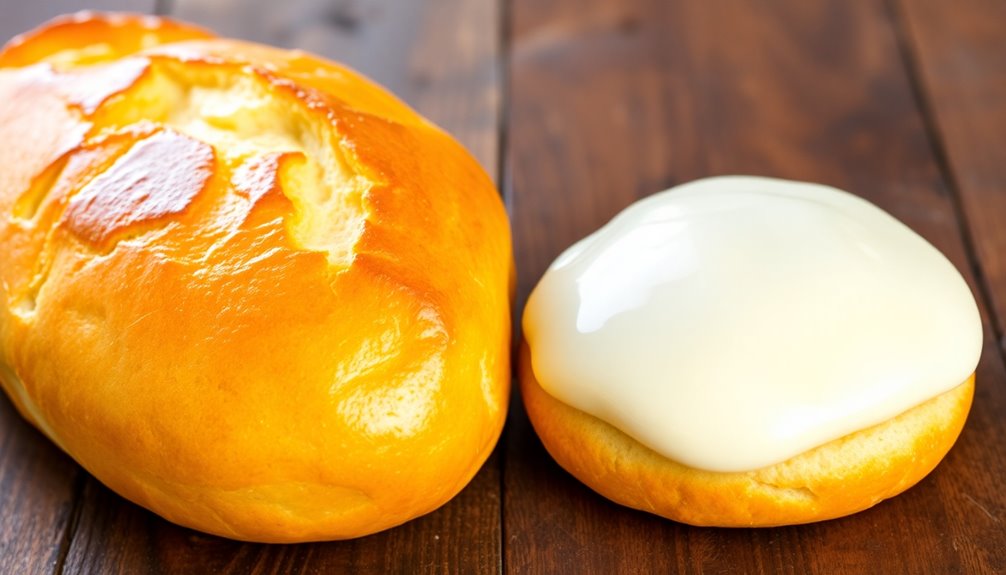
When it comes to baking, personal preference can greatly influence the choice between butter and margarine, shaping both the process and the final outcome.
You might prefer butter for its rich flavor and ability to create a light, flaky texture, especially essential in pastries like croissants. The high fat content of butter locks in moisture, enhancing the overall taste compared to margarine, which can lead to greasier, denser baking outcomes.
If you opt for margarine, you may appreciate its cost-effectiveness or dietary compatibility, but you might notice that baked goods spread more and lack structure.
Ultimately, whether you choose butter or margarine can considerably alter the texture and flavor of your cookies and pastries.
Frequently Asked Questions
Is It Better to Bake Bread With Butter or Margarine?
When you're deciding whether to bake bread with butter or margarine, consider the flavor and texture you want.
Butter's richness enhances the taste and creates a light, flaky texture, while margarine can make your bread denser and greasier.
If you're aiming for a perfect rise and crisp edges, butter's lower melting point and higher fat content deliver better results.
Is Pastry Better With Butter or Margarine?
When it comes to pastries, you'll want to go with butter if you're aiming for that melt-in-your-mouth quality.
Butter's high fat content gives your pastries a light, flaky texture, while its rich flavor elevates every bite.
Margarine can't quite match that creamy taste and tends to make things a bit dense.
Why Do Bakers Use Margarine Instead of Butter?
Bakers often choose margarine over butter for several reasons.
It's usually cheaper, making it a smart choice for large batches. With a higher water content, margarine can create a softer texture, which you might prefer in certain baked goods.
Its consistent fat and water ratio guarantees predictable results, while being vegan-friendly, it accommodates dietary restrictions.
Plus, lack of milk solids means less browning, keeping your pastries looking light and appealing.
Do Bakeries Use Butter or Margarine?
When you walk into a bakery, you can taste the love, the dedication, and the quality in every bite.
Most bakeries choose butter over margarine, and it's no surprise. Butter adds a rich flavor, creates flaky textures, and delivers consistent results that bakers appreciate.
While some might opt for margarine to cut costs, it often results in denser products. Ultimately, bakeries committed to quality know that butter makes all the difference in their creations.
Conclusion
In the end, choosing between butter and margarine really boils down to your personal taste and baking goals. Think of it like crafting a beautiful tapestry; butter adds rich, vibrant colors, while margarine provides a smooth, consistent backdrop. When I once baked a loaf using half butter and half margarine, I discovered a delightful balance—crisp edges with a soft, buttery heart. So, whether you go for the classic or the modern, trust your palate and let your creativity shine!
